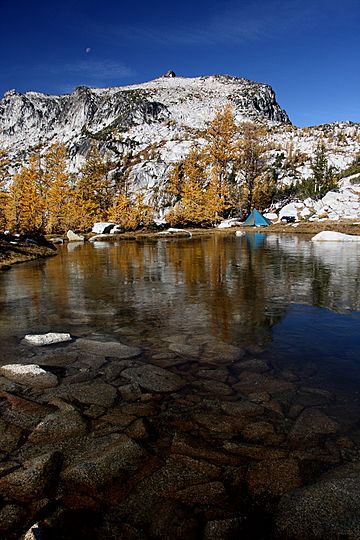Enchantment Peak facts for kids
Quick facts for kids Enchantment Peak |
|
|---|---|

Enchantment Peak seen from Gnome Tarn
|
|
| Highest point | |
| Elevation | 8,520 ft (2,600 m) |
| Prominence | 480 ft (150 m) |
| Geography | |
| Parent range | Cascade Range |
| Topo map | USGS Enchantment Lakes |
| Type of rock | Granite |
| Climbing | |
| First ascent | May 1948 by Fred Beckey |
| Easiest route | Scrambling class 2 |
Enchantment Peak is a tall mountain made of granite. It stands at about 8,520 feet (2,597 meters) high. You can find it in Chelan County, in Washington state.
This peak is a special part of an area called The Enchantments. It's also inside the larger Alpine Lakes Wilderness. Enchantment Peak belongs to the Stuart Range, which is part of the huge Cascade Range. It sits between Prusik Peak to the east and Aasgard Pass and Dragontail Peak to the west. Water from the peak flows into Icicle Creek, which then joins the Wenatchee River.
Contents
Weather at Enchantment Peak
Most of the weather systems that affect Enchantment Peak start over the Pacific Ocean. They travel east until they hit the Cascade Mountains. When these weather systems reach the tall mountains, they are forced to rise up.
How Mountains Make Rain and Snow
As the air rises, it cools down. This cooling makes the moisture in the air turn into rain or snow. This process is called orographic lift. Because of this, the Cascade Mountains get a lot of rain and snow, especially in winter.
Seasonal Weather Patterns
In winter, the weather is often cloudy and snowy. However, during the summer, high-pressure systems over the Pacific Ocean become stronger. This usually means there are clear skies and very few clouds. The snow here tends to be wet and heavy because of the ocean's influence. This can sometimes lead to a high risk of avalanches.
How Enchantment Peak Was Formed
The Alpine Lakes Wilderness area has very rugged land. It features sharp peaks, long ridges, and deep valleys carved by glaciers. There are also many granite walls and over 700 mountain lakes. Amazing geological events happened millions of years ago to create this varied landscape. These events also caused the big changes in elevation, which led to different climates.
Ancient Earth Movements
The Cascade Range began forming millions of years ago, during a time called the late Eocene Epoch. This happened when the North American Plate slowly moved over the Pacific Plate. This movement caused many volcanic eruptions and created new rock.
Small pieces of the Earth's crust, called terranes, also joined together. These pieces helped form the North Cascades about 50 million years ago.
Ice Ages and Glaciers
About two million years ago, during the Pleistocene period, huge sheets of ice called glaciers moved across the land. These glaciers advanced and then melted back many times. As they moved, they scraped and shaped the landscape, leaving behind piles of rock.
The last glaciers in the Alpine Lakes area started to melt about 14,000 years ago. They had moved north of the Canada–US border by 10,000 years ago. The "U"-shaped valleys you see today were carved out by these powerful glaciers. The combination of land being pushed up (uplift) and cracks forming in the Earth (faulting), along with glaciation, created the tall peaks and deep valleys of the Alpine Lakes Wilderness.



